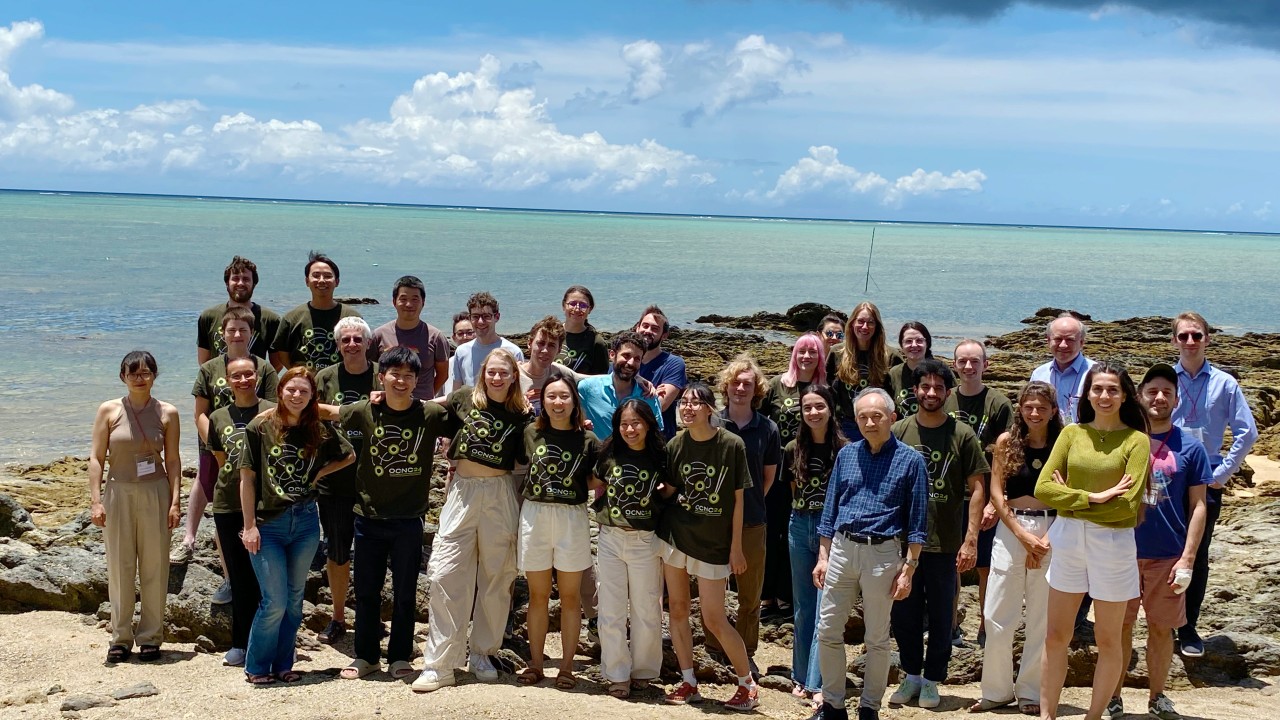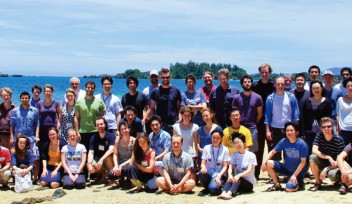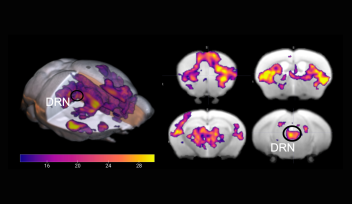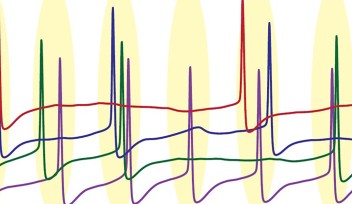Happy 20th Anniversary, OCNC!

This year, participants from around the world gathered for the twentieth summer school on computational neuroscience organized by the Okinawa Institute of Science and Technology (OIST) in Japan. Remarkably, this course pre-dates the university’s founding in 2012 by welcoming its first participants in 2004.
“As soon as we started initial research activities in Okinawa, Prof. Sydney Brenner, then president of the OIST Promotion Corporation, asked me to organize an international summer school on computational neuroscience. I was very excited to organize a new summer school on an international scale,” remembers Prof. Kenji Doya, the head of OIST’s Neural Computation Unit and lead organizer of the first OCNC.
Under the topic “Bayesian Brain”, the first summer school was held at Bankoku Shinryo-kan, with generous support from the Cabinet Office of the Japanese Government, which remains to fund OIST. Leading researchers and aspiring students came together for lectures on analyzing neural data and modeling brain function using Bayesian statistics, which proved highly productive and culminated in the publication of a book of the same name by MIT Press in 2006. “Even though the course was originally planned as a one-time event, I thought we should hold it every year, and I am so happy to see this continued for 20 years,” reflects Prof. Doya.

In the same year, the OCNC celebrated a milestone by finding its permanent home in OIST’s newly opened Seaside House. The same year, Erik De Schutter, who later became the head of the Computational Neuroscience Unit at OIST, joined as a lecturer. “During the course, Erik came up to me and asked me to introduce him to Dr. Sydney Brenner,” remembers Prof. Doya.
Despite OIST being such a young research institute in 2006, Prof. De Schutter had already heard about the institute and took the opportunity to start a conversation about joining. “I came to this summer school well prepared,” says Prof. Erik De Schutter. One year later, he put his tenured position at the University of Antwerp on hold to become a faculty member at OIST. With that, he also became part of the OCNC’s organizing team and introduced a new element: a strong focus on student-initiated projects.
When submitting their applications, all students propose short project ideas on which they will work intensely during the three-week course. These projects are a central part of the course because they give the participants hands-on experience in computational neuroscience and allow them to dive deep into a topic of their choice, often relevant to a problem they currently face in their research. This intense project focus is not only a point of pride for the organizers but also makes the OIST’s summer school stand out in the field, “As far as I know, the OCNC is the only computational neuroscience summer school that has such a strong focus on student-initiated projects,” adds Erik De Schutter.
For the 20 open spots in 2024, around 200 applications were submitted. The selection process is split into two rounds to select the best candidates for the OCNC. First, the organizers evaluate the anonymized submission based on research interest and project proposal. From this first list of candidates, they select the final participants based on additional criteria, including the field, country of origin, gender, and more, trying to give everyone as fair a chance as possible.
To ensure the selected candidates have a great experience at the OCNC, they get organizational support even during their time in Okinawa. Chie Narai, a Research Unit Administrator in the Computational Neuroscience Unit, makes sure the summer school runs smoothly. “Most people are in Okinawa for the first time, and I support them throughout their stay. I introduce the participants to the local food or help if somebody gets sick, to name a few examples,” she says.
Efforts that were appreciated by the participants, who especially enjoyed the chance to meet with other members of their field from across the globe, “it's cool to meet many different people from all over the world; the OCNC is also a great networking opportunity,” said one of this year’s participants.
These professional networks formed in Okinawa often last for the lifetime of a career. Prof. Alex Cayco-Gajic, a Junior Professor at the École Normale Supérieure in Paris, France, first joined the OCNC in 2012 as a participant. At the time, she was a PhD student in applied mathematics and applying for all significant computational neuroscience summer schools, including the OCNC.
Participating in this summer school provided Prof. Cayco-Gajic with an opportunity to take her career further into the field of neuroscience, “this was the first time I had an opportunity to speak to experimental neuroscientists,” she says. Twelve years later, she is working with statistical methods to extract information from large-scale neuronal recordings that her experimental colleagues take to understand processes in the brain better.
For the summer school's 20th anniversary, she looked back at how quickly new tools changed the field of computational neuroscience. When she started her career, machine learning was not yet a common tool, but especially over the past decade, this method has become an integral part of neuroscientific research. “It was exciting to witness this development. I didn't think such a big shift in my scientific field would happen during my lifetime,” says Prof. Cayco-Gajic.
Not only has the way data is analyzed changed notably, but also the possibilities in experimental science. Newer technologies make it possible to measure the activity of hundreds of thousands of neurons in animals completing behavioral tasks. This latest technological trend also impacted this year's OCNC course, where many projects included neural data from behavioral studies.
While this 20th anniversary offered an opportunity to reflect, it is also a time to look towards OCNC’s future, “for the future, we hope to continue providing the basics of computational neuroscience and introducing new theories and technologies to our students. Also, larger-scale data is becoming available, for example, from single-cell transcriptomics and connectomes. Finding ways to use these huge data sets to make discoveries is a major challenge in computational neuroscience,” says Prof. Doya.
Specialty
Research Units
For press enquiries:
Press Inquiry Form














